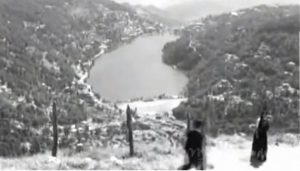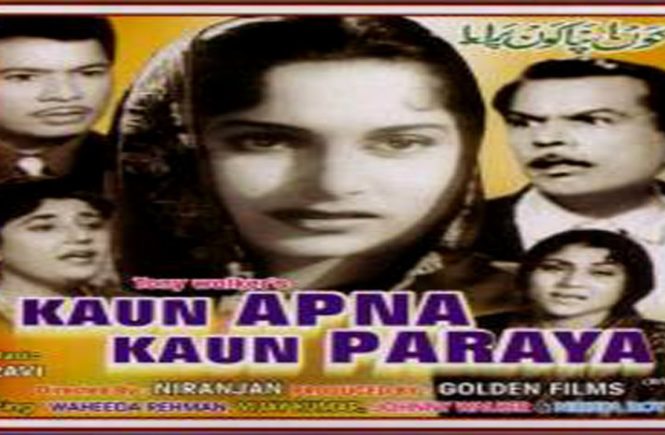Raaga Based Song of the Day: Zara sun haseena ai nazneen…
Raag Pahadi, Tal Rupaktal
We have completed seven days of Raaga Based Songs of the Day. Although our first post in the series was titled ‘Raaga Based Song Of The Day #1’ and the song was a Mohammad Rafi and Lata Mangeshkar song from the 1970 Shakti Samanta movie Pagla Kahin Ka: Tum mujhe youn bhula na paoge (It is in Raag Jhinjhoti, Tal Kaherava), the fact is that on WhatsApp groups I had started with these posts three or four days before putting them up here on this blog. Yesterday onwards, I am merging these posts.
Our seventh post or the last post was titled ‘Raaga Based Song Of The Day #7’ and the song was a Geeta Dutt (when she was still Geeta Roy) song from the 1951 Guru Dutt movie Baazi: Aaj ki raat piya dil na todo. It is in Raag Pahadi, Tal Dadra.
This blog has a number of posts on Raaga based songs in Hindi movies titled similarly; for example: ‘The Best Raaga Based Songs in Hindi Movies – Raaga Jhinjhoti – Part II’.
Raag Pahadi again!
There is no doubt in my mind that the best of any genre’ of music has been sung by the god of songs: Mohammad Rafi.
The best in Raag Pahadi is also by him: Chaudhvin ka Chand, in Taal Kaherava.
By the way, my favourite lyricist Shakeel Badayuni received his first Filmfare Award in 1961 for this song. Shakeel’s association with Ravi resulted in some remarkably beautiful songs sung by Mohammad Rafi. The theme of describing husn (beauty) of the woman was prominent in these songs. Indeed the second song for which Shakeel received his Filmfare Award in 1962 was also a husn song: Husn wale tera jawab nahin for the movie Gharana.
In 1963 movie Kaun Apna Kaun Praya, Shakeel, Ravi and Rafi made yet another enchanting husn song that Vijay Kumar lip-synced to Waheeda Rehman.

You can feel the Pahadi dhun with Rupaktal. I have told you enough about Pahadi, let me give you a few songs in Rupaktal though not in Pahadi. Before that: Rupak is unique among the tals in that the first beat (ie, the sam) is khali (ie., represented by a wave of the hand).
wave, 2, 3, clap, 2, clap, 2
Some songs in Rupaktal: Aap ki nazaron ne samajha, Ghar aaja ghir aaye badra sanwariya, Haay re vo din kyun na aaye, Kisi raah pe kisi mod par, Piya tose naina laagi re, Tum gagan ke chandrama and Megha chhaye aadhi raat.
What about the value-added learning for today? Well, today, we shall learn about parts of a compostion in Indian Classical Music.
In Indian Classical Music, a composition has four parts, of which only the first two are performed regularly:
- Asthaai including mukhda.
- Antara.
- Sanchari.
- Abhog.
The other day (Raaga Based Song Of The Day #2), I mentioned to you the concept of Sam – the first beat of a taal (rhythm) cycle. It is also the syllable(s) of the bandish (composition) on which the first beat of the taal cycle falls. When an artist begins a composition, the tabla enters at the sam syllable.
Reshma Hingorani, in her celebrated blog on Indian Classical Music explains this with an example (a bandish in afternoon raag, Shuddha Sarang: Ab mori baat maan le piharava) and it is worth going through that.
She then gives description of each part:
- Asthaai (pallavi in Carnatic music, base or refrain in western music) is the first part of a composition, its first line serving as a Mukhda, while the Asthaai itself serves as a base for the singer to returns to, repeatedly.
- Mukhda: literally ‘face’, is the opening phrase of an asthaai, which comes before, leads up to, and arrives on the sam. So a mukhda introduces and sets the tone. When artists improvise, they return to the Asthaai periodically, by picking up the mukhdaa at the right time.
- Antara: literally ‘within’; (Anupallavi in Carnatic music, “Stanza” or “verse” in western music). It is the second part, a continuation from where the mukhda left off, sung in a high octave, focusing on the taar shadaj, with a good deal of text manipulation and repeated forays into asthaai.
- Sanchari: literally, “wandering”; the 3rd section (Charanam in Carnatic music) – remains a free-flowing, section.
- Abhoga: 4th or concluding section (Pallavi in Carnatic music); includes notes from all three octaves, and in present-day performances, may well be sung with the Sanchari, if these two sections are included.
The song Zara sun haseena ai naazneen takes you straight to the hills (where I am) with its Raag Pahadi, Tal Rupaktal and beautiful rendition by Mohammad Rafi.
Please enjoy: Zara sun haseena ai nazneen…
Zaraa sun hasiinaa ai naazanii.n
meraa dil tujh hii pe nisaar hai
tere dam se hii mere dilarubaa
merii zi.ndagii me.n bahaar hai
hu_ii jab se mujh pe terii nazar
mai.n huu.N apane aap se beKabar
hu_aa jab se dil me.n teraa guzar
mujhe chain hai na qaraar hai
tere husn se jo sa.Nvar ga_ii
vo fizaa_e.n mujhako aziiz hai.n
terii zulf se jo lipaT ga_ii.n
mujhe un havaa_o.n se pyaar hai
ye hasiin phuulo.n kii Daaliyaa.N
tujhe de rahii hai salaamiyaa.N
mujhe kyo.n na rashq ho ai sanam
tere saath fasl-e-bahaar hai
We have intended to learn about Raaga based music whilst we entertain ourselves with Raaga based songs. So, lets, once again, take stock of our collective learning so far:
- On the first day we learnt about the Raaga system devised by Pandit Vishnu Narayan Bhatkhande, which is the prevalent system in Hindustani Classical Music and based on ten Thaats.
- On the second day we learnt about Tal or Taal.
- On the third day we learnt about characteristics of Raagas that included Swar, Jati, Thaat, Arohana and Avarohana, Vadi, Samvadi and Pakad.
- On the fourth day, we learnt about Sargam.
- On the fifth day, we learnt about notations used in Indian classical music or simply Swar Lipi.
- On the sixth day, we learnt about the Ras (sentiments) that Raagas evoke.
- On the seventh day, we learnt about various types of Swar: Shuddha, Achal, Vikrut, Komal and Teevra.
- And today, on the eighth day, we learnt the parts of a composition in Indian Classical Music.
There is much more still to be learnt and enjoyed.
Please stay tuned!
